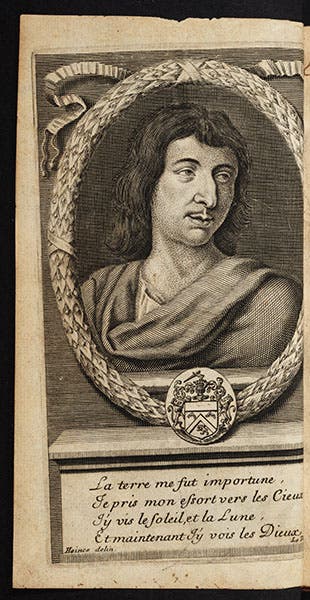Scientist of the Day - Cyrano de Bergerac
Cyrano de Bergerac, a French writer and playwright, was born Mar. 6, 1619. Most people know the Cyrano of Edmund Rostand's 1897 play, the proboscidly-precocious pursuer of the lovely Roxanne, but the real Cyrano was even more interesting, since he was a student of the French atomist, Pierre Gassendi, and a proponent of a sun-centered cosmology in a Catholic France that was, officially at least, still resistant to Copernicanism. Cyrano found a vehicle for his views in an account of a voyage to the Moon, published posthumously as L'Autre Monde: les États et Empires de la Lune (The Other World: The States and Empires of the Moon, 1657).
The 17th century saw a number of such imaginary voyages to the Moon, by the likes of Johannes Kepler and Francis Godwin, but Cyrano's trip is notable because of his motive power - his craft was propelled by firecrackers! This was not exactly rocket science, but it was close (Godwin had flown to the moon in a rig powered by 25 geese!). Once he arrives on the moon, the unnamed narrator (whom we assume to be Cyrano) finds that the ruling race is quadrupedal and the menials are bipeds, and the Moon creatures refuse to believe that the Earth is inhabited, because it is just a moon of the Moon, and moons are never inhabited.
Cyrano's pioneering work of science fiction is very scarce; we have never seen a first edition. The work was translated into English in 1659, and that edition is just as rare. In 1687, there was another English translation, and this one comes on the market every now and then, although we have never been able to afford it. The frontispiece (first image) is supposed to depict Cyrano's first attempt at lunar flight, using bottles of dew strapped to his body, the evaporation of which would carry him upward, although it is not a very convincing depiction. The dew bottles got Cyrano only as far as Canada, where he had to resort to his firecracker firepower to carry him the rest of the way.
The only version of Cyrano’s lunar voyage that we have in the Library is part of a 1703 collection of his works (second image). Our copy has no engraving of the journey, but it does have a frontispiece portrait of Cyrano (third image). Cyrano was no relation to the 18th-century Swiss scientist who claimed to be his grand-nephew, Cyano de Bergerac.
Dr. William B. Ashworth, Jr., Consultant for the History of Science, Linda Hall Library and Associate Professor, Department of History, University of Missouri-Kansas City. Comments or corrections are welcome; please direct to ashworthw@umkc.edu.








